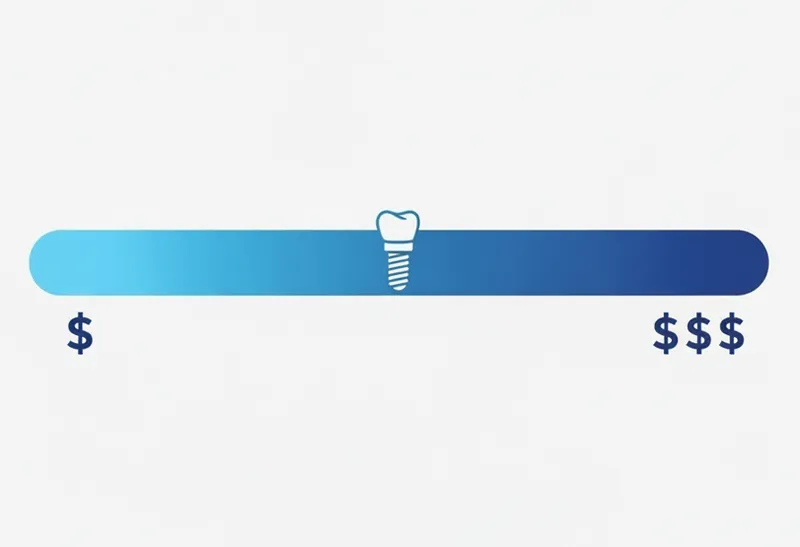The Big Reasons Prices Range So Much

Contents
Introduction
Two quotes can look very different because they may include different work. Ask: what’s included, who’s doing it, how is it done, and what are the teeth made of? Those answers explain most of the price spread. (AAOMS Oral and Maxillofacial Surgeons)
The Big Reasons Prices Range So Much
-
1) How many Implants & Which Jaw(s)
Full-arch can mean 4, 5, 6 or more implants per arch. Upper jaws often need extra planning because bone quality can be softer and the sinus may be involved—factors that can add appointments and parts.(AAOMS Oral and Maxillofacial Surgeons)
-
2) Bone, Sinus, and Medical Complexity
Grafting, sinus lifts, or managing medical risks (like diabetes or smoking) add visits, materials, and follow-up. Smoking, in particular, is linked with higher implant-failure risk, so your team may stage treatment more cautiously. (PubMed)
-
3) Who’s on your Care Team
A true team approach (oral surgeon + anesthesiologist + prosthodontist + surgical assistants) is different from a one- or two-person office. More specialized expertise can improve control and predictability, but it also means more people and time are involved.
-
4) Type of Anesthesia & Staffing
Local anesthesia or light IV sedation is priced differently than deep sedation/general anesthesia with a dedicated anesthesia provider and monitoring staff. Safe office-based anesthesia follows published guidelines and requires trained personnel and equipment—important for safety and part of the fee. (ADA)
-
5) Guided Surgery, Digital Planning & Records
Computer-guided surgery, CBCT-based planning, photogrammetry, and printed guides add planning time and lab steps. Many centers invest in these tools to place implants where the future teeth need to be for better long-term mechanics—often worth the upfront cost for precision.
-
6) "Teeth in a day" vs Staged Timelines
Immediate-load (same-day fixed teeth) can perform comparably to delayed loading in selected cases, but it demands meticulous planning and more parts/lab work on day one. Others stage provisionals and final teeth over months. Different timelines = different line items. (Cochrane Library)
-
7) Temporary and Final Teeth Materials
Common final options include:
- Metal framework + acrylic/composite ("hybrid"): lighter and repairable; teeth/base can wear over time.
- Monolithic zirconia: very strong and aesthetic; needs precise design and careful bite planning.
Material choice changes lab time, hardware, and expected maintenance patterns.
-
8) In-house vs Outsourced Lab Work
When the surgical team and lab plan/build together in one system, you pay for that integration—yet it can reduce remakes and extra visits. Outsourcing may have a lower sticker price but can add variability.
-
9) Warranty, Maintenance & Redo Care
Ask what's covered for repairs, screw access, night guards, or replacing worn teeth. Centers that commit to maintenance usually build those visits into the fee. However, redo cases from elsewhere are often the most complex and are sometimes charged as such.
-
10) Location, Facility & Overhead
Surgical centers with dedicated OR equipment, sterilization, and in-house imaging carry different overhead than a basic operatory. Geography also plays a role in the cost. (AAOMS Oral and Maxillofacial Surgeons)
What to Expect from a Smileloc Quote
We offer each arch at $17,995. This means $35,990 for both upper and lower arches– top and bottom set of teeth. This price stays constant regardless of the number of implants and medical complexity and includes the guided surgeries, full anesthesia, 48 hour immediate smile, your finals, and hygiene maintenance.
Related Reading: Learn more about common All-on-X failures and how to avoid them , or explore the complete journey from dentures to Smileloc
Costs and Financing — How to read a proposal
Use this 6-question checklist to decode any quote:
-
1. How many implants per arch? (and why)
Understanding the reasoning behind the number of implants helps you evaluate if the approach makes sense for your specific case.
-
2. Who is placing them? (training/experience) and who's doing anesthesia? (dedicated provider? monitoring?)
The skill level of your surgical team and anesthesia provider directly impacts safety and outcomes. (ADA)
-
3. Is surgery guided? (are guide design, parts, and scans included?)
Computer-guided surgery improves precision but adds to costs. Make sure you understand what's included in the guided surgery package.
-
4. What's the temporary plan? (same-day or staged; what if you're not an immediate-load candidate?)
Different treatment timelines affect both cost and your experience. Know your options if immediate loading isn't recommended for your case. (Cochrane Library)
-
5. What are the final teeth made of? (and what's the maintenance plan?)
Material choice affects both upfront cost and long-term maintenance. Understand what you're getting and what ongoing care will be needed.
-
6. What's included after surgery? (maintenance visits, protective night guard, repairs/warranty)
Post-surgical care can add significant costs. Clarify what's covered and what you'll pay for separately.
Financing & Insurance
Coverage varies widely by plan. A predetermination (pre-authorization) helps you understand benefits before treatment so you're not surprised. HSAs/FSAs can often be used for eligible costs. (ADA)